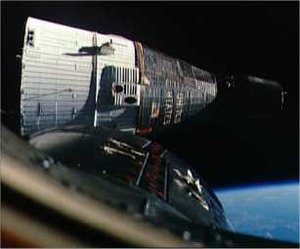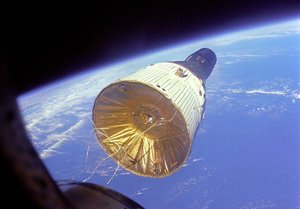Gemini 6A
|
|
| Mission Insignia | |
|---|---|
| Missing image Ge06Patch_embr.jpg Gemini 6A Insignia | |
| Mission Statistics | |
| Mission Name: | Gemini 6A |
| Call Sign: | Gemini 6A |
| Number of Crew: | 2 |
| Launch: | December 15, 1965 13:37:26.471 UTC Cape Canaveral LC 19 |
| Stationkeeping w/GT-7: Start: End: | December 15-16, 1965 19:33 UTC 00:52 UTC |
| Landing: | December 16, 1965 15:28:50 UTC Template:Coor dm |
| Duration: | 1 day, 1 hour 51 minutes 24 seconds |
| Distance Traveled: | ~694,415 km |
| Orbits: | 16 |
| Apogee: (1st orbit) | 259.4 km |
| Perigee: (1st orbit) | 161 km |
| Period: (1st orbit) | 88.7 m |
| Inclination: | 28.97 deg |
| Mass: | 3,546 kg |
| Crew Picture | |
| Missing image S65-56151.jpg Gemini 6A crew portrait (L-R: Stafford, Schirra) Gemini 6A crew portrait (L-R: Stafford, Schirra) | |
| Gemini 6A Crew | |
Gemini 6A (officially Gemini VI-A) was a 1965 manned spaceflight in NASA's Gemini program. It was the 5th manned Gemini flight, the 13th manned American flight and the 21st spaceflight of all time (includes X-15 flights over 100 km).
| Contents |
Crew
- Wally Schirra (flew on Mercury 8, Gemini 6A, & Apollo 7), Command Pilot
- Thomas Stafford (flew on Gemini 6A, Gemini 9A, Apollo 10, & Apollo-Soyuz), Pilot
Backup Crew
- Virgil I. Grissom, Command Pilot
- John W. Young, Pilot
Mission Parameters
- Mass: 3,546 kg
- Perigee: 161 km
- Apogee: 259.4 km
- Inclination: 28.97°
- Period: 88.7 min
See also
Objectives
Gemini 6 was originally intended to be the first mission to dock with an Agena Target Vehicle. However, after a failure in the Agena target 6 minutes after its launch (when the crew of Gemini 6 was already sitting in their capsule waiting for their launch), the mission was canceled. Reviewing the situation, NASA decided to substitute an alternate mission: a meeting in space of two Gemini spacecraft. The new mission would be knowns as Gemini 6A, and would launch eight days after the launch of Borman and Lovell's Gemini VII. Schirra and Stafford tried to join them, but their Titan 2 launcher shut down on the pad (the cool-headed Schirra did not eject, even though the countdown clock had started ticking-he felt no motion, and trusted his senses). Three days later, Gemini 6A made it into orbit. Using guidance from the computer as well as his own piloting, Schirra rendezvoused with the companion spacecraft in orbit on the afternoon of December 15. Once in formation, the two Gemini capsules flew around each other, coming within 0.3 meters of each other but never touching. The two spacecraft stayed in close proximity for five hours. One of Gemini's primary goals-orbital rendezvous-had been achieved.
| Gemini 6 | Agena Info |
|---|---|
| Agena | GATV-5002 |
| Mass | 3,261 kg |
| Launch Site | LC-14 |
| Launch Date | October 25, 1965 |
| Launch Time | 15:00:04 UTC |
| Exploded | 15:06:20 UTC |
Flight
First launch attempt
The first launch attempt of Gemini 6A was on December 12. All went well right up to ignition--in fact the engines did ignite. But then a plug fell out of the bottom of the rocket starting the onboard programmer. This was not meant to happen until the rocket had actually lifted off. So the onboard computer detected that there was no upwards motion and aborted the launch. At this point mission rules dictated that the crew should eject from the spacecraft, as even if the rocket had lifted off an inch it would explode as it came crashing back onto the pad.
Schirra elected not to eject. Neither he or Stafford had detected any upwards motion. And the ejection seats were seen as a last resort. An early test of the system involved a dummy. The hatch for some reason failed to blow off and the dummy's head was rammed into the side of the spacecraft. The astronauts watching commented that this would cause one hell of a headache--but a short one! Also all ejection seats cause compression of the spine and these were designed to send the astronauts a couple of hundred metres away from an exploding rocket.
The Martin and Air Force teams who erected and tested the rocket found that some of plugs on the rocket were able to pull out easier than others. They replaced them with the ones that were harder to pull out and on future missions, a safety wire was added to make sure that the rocket had really lifted off.
Another problem however was found. As the engineers examined the thrust versus time graph they found that it rose nominally but started to get lower, before the plug had fallen out. Through the night, engineers examined the rocket engine piece by piece until they found that a plastic cover had been left in the gas generator port. With this problem solved the rocket and spacecraft were recycled for a launch 72 hours after the first attempt.
Rendezvous
The third attempt to launch Gemini Spacecraft Number 6 was finally successful on December 15. All went well through launch and ascent and they entered into a 161 by 259 kilometres orbit.
The plan called for the rendezvous to take place on the fourth orbit of Gemini 6A. Their first burn came 94 minutes after launch when they increased their speed by 5 metres per second. Due to their lower orbit they were gaining on Gemini 7 and were only 1,175 kilometres behind. The next burn was at 2 hours and 18 minutes when Gemini 6A made a phase adjustment to put them on the same orbital inclination as Gemini 7. They now only trailed by 483 kilometres.
The radar on Gemini 6A first made contact with Gemini 7 at 3 hours and 15 minutes when they were 434 kilometres away. A third burn put them into a 270 by 274 kilometre orbit. As they slowly gain Schirra put Gemini 6A's computer in charge of the rendezvous and then at 5 hours and 4 minutes he saw a bright star that he thought was Sirius, but was in fact Gemini 7.
After several more burns the two spacecraft were only 40 metres apart. The burns had only used 51 kilograms of fuel on Gemini 6A, giving plenty of fuel for some fly arounds. During the next 270 minutes the crews moved as close of 30 centimetres to 90 metres, talking over the radio. At one stage the spacecraft were stationkeeping so well that neither crew had to make any burns for 20 minutes.As the sleep periods approached Gemini 6A made a separation burn and slowly drifted out to 16 kilometres. This stopped any accidental collisions in the night. But before everyone went to sleep, the crew of Gemini 6A had a surprise for everyone.
Gemini VII, this is Gemini VI. We have an object, looks like a satellite going from north to south, probably in polar orbit. . . . Looks like he might be going to reenter soon. Stand by one. . . . You just might let me to pick up that thing.
At that point, the sound of "Jingle Bells" was heard.
Reentry
Gemini 6A reentered the next day landing within 18 km of the planned site, the first truly accurate reentry. It was also the first to be televised live, through a satellite linkup from the recovery aircraft carrier USS Wasp.
The Gemini 7 & 6A missions were supported by the following U.S. Department of Defense resources; 10,125 personnel, 125 aircraft and 16 ships.
Insignia
Walter Schirra explained the patch in his book All We Did Was Fly to the Moon:
The Gemini 6 patch is hexagonal in shape, reflecting the mission number; and the spacecraft trajectory also traces out the number "6". The Gemini 6 spacecraft is shown superimposed on the "twin stars" Castor and Pollux, for "Gemini". I designed the patch to locate in the sixth hour of celestial right ascension. This was the predicted celestial area where the rendezvous should occur (in the constellation Orion). It finally did occur there.
Capsule Location
The capsule is currently on display at the Omniplex Science Museum (http://www.omniplex.org), Oklahoma City on a long term loan from the Smithsonian Institution. Formerly, it was displayed at the St. Louis Science Center in St. Louis, Missouri.
External links
- Gemini 6 Mission Report (PDF) - October 1965 cancelled mission (http://ntrs.nasa.gov/archive/nasa/casi.ntrs.nasa.gov/19790076749_1979076749.pdf)
- Gemini 6/Agena target vehicle 5002 systems test evaluation (PDF) December 1965 (http://ntrs.nasa.gov/archive/nasa/casi.ntrs.nasa.gov/19750069069_1975069069.pdf)
- On The Shoulders of Titans: A History of Project Gemini (http://www.hq.nasa.gov/office/pao/History/SP-4203/cover.htm)
- Spaceflight Mission Patches (http://www.genedorr.com/patches/Intro.html)
- http://www.collectspace.com/news/news-092703a.html


